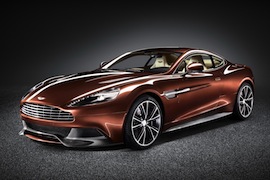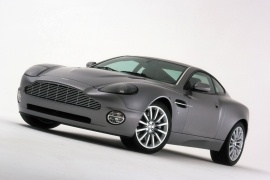ASTON MARTIN Vanquish Models/Series Timeline, Specifications & Photos
First production year: 2001
Engines: Gasoline
Body style: Coupé (two-door)
In a world dominated by hybrid sports cars with low-displacement engines, Aston Martin dared to be different and unleashed the 2025 Vanquish with a gasoline-only turbocharged powerhouse.
It was obvious for many sports car manufacturers that they had to adapt to the new, electrified era. Little by little, they made hybrid drivetrains that focused on performance rather than fuel efficiency, which was OK. However, Aston Martin took a different path when it developed the 2025 Vanquish. For its most famous nameplate, the British brand used a twin-turbocharged, 5.2-liter V12 engine. Furthermore, it wasn’t placed behind the cockpit but in front of it to get a better weight distribution. As a result, the 2025 Aston Martin Vanquish looked like a grand tourer even though it could compete side by side with most supercars on the market at the time of the car’s unveiling in September 2024.
Right off the bat, it was obvious that the 2025 Aston Martin Vanquish was no ordinary car. It looked outrageous even if compared to its siblings. The front shell-shaped grille was broader than on any other Aston Martin vehicle. However, the car manufacturer used the same headlights as its Vantage stablemate. They sported LED daytime running lights that doubled as turn signals on the upper side and Matrix Headlights on the lower area.
Viewed from its profile, the 2025 Aston Martin Vanquish impressed the audience with its long hood, which resembled a grand touring car. In addition, the hood sported two sets of six functional vents, one for each cylinder. Moving on, the car impressed with its longer wheelbase compared to Aston Martin’s previous flagship model, the DBS 770 Ultimate. The front fenders had a set of exhausts adorned by arrow-like trims and sported a discreet Aston Martin V12 badge. Moving on to the sides, the vehicle featured long doors with flush door handles that popped out when their opening button was pressed or when the owner unlocked the car. At the back, the British sports car manufacturer installed a broad plate featuring the Aston Martin chromed lettering on a body-colored or carbon fiber panel, depending on the options. It was flanked by seven LED lamps with a design that resembled those from the Valkyrie hypercar. Underneath the bumper, the automaker installed a massive diffuser that created downforce and integrated the four exhausts. Surprisingly, there was no Vanquish badge on the entire vehicle. Customers didn’t need one to know what this car was about.
Inside, the leather-wrapped cabin was fit for two adults. Due to the long engine bay, they stood almost in the middle of the vehicle and were spoiled by the automaker with a cockpit that breathed a mix of luxury and sportiness. Fronting the driver was a 10.25” digital instrument panel, while the center stack supported a same-size touchscreen for the infotainment system. Wireless Apple CarPlay connectivity was standard, while the Android Auto required a wired connection. The front sports seats were utterly covered in leather, and their power adjustment buttons were placed on the wide center console.
However, the technology package and the engineering details made the 2025 Aston Martin Vanquish stand apart from its competition. Its carbon fiber bodywork was wrapped around an aluminum structure to reduce weight. Furthermore, the automaker installed ceramic brakes and forged 21-inch alloy wheels that reduced unsprung weight by more than 27 kilos (59.5 lbs.). The all-wheel independent suspension ensured customers that the car’s platform was ready for high-speed cornering. In addition, an electronically-controlled limited slip differential was also standard and could switch from free-wheel to fully locked in a mere 135 milliseconds. Under the hood, Aston Martin installed a 5.2-liter twin-turbocharged V12 powerplant that the car manufacturer researched extensively. As for performance, the 3.2-second time from naught to 60 mph (97 kph) was just part of the package. The eight-speed automatic transmission was the only option.
Even though it looked like a restyled DB9, the 2012 Vanquish was far more than that, and it was a new car with an older, yet updated, look.
With extensive use of carbon fiber elements and shallow aluminum parts instead of solid cast ones, the Vanquish managed to shave 40 kg (88 lbs) from the DBS weight and. Moreover, Aston Martin spelled the engine to produce more power from the magnificent V-12 engine under the hood.
Aston Martin is not a British Ferrari. It is more of a GT vehicle that can outpace some Ferraris on a track. That said, it was normal to see the Vanquish with a long hood and swept lines that formed a beautiful, fluid design. It looked almost organic, and its lines were derived from the original project imagined by Ian Callum. In the rear, the cut-out spoiler on the trunk-lid was unique for the British brand. The One-77 style doors, on the other hand, were not original to the model but specific for the brand.
Inside, there was nothing to resemble the glorious racing past of the Aston Martin brand. It showed a typical British style with wood-trims and a leather-wrapped interior. Even the piano-black plastic parts looked exquisite on the center stack.
Under the hood, Aston Martin engineers crafted a 5.9-liter engine that provided 510 hp of pure happiness and joy. The naturally aspirated V-12 unit was engineered to deliver a gentle, predictable power flow to the six-speed automatic gearbox. And that's how a great GT could be better than a fierce supercar.
The 2001 Aston Martin Vanquish was the most exclusive vehicle built by the British company at the beginning of 2000. It was based on the 1998 Aston Martin Project Vantage concept car.
The Aston Martin Vanquish was designed by Ian Callum and it promised supercar performances into a classic design package. The idea behind the vehicle was to inject adrenaline into a Grand Tourer. Usually, any GT car was able to put down some good performances, but its main reason was a luxurious interior mated to a powerful engine able to soak up the roads. The Aston Martin Vanquish dared to be even more than that.
From the specific grille design shaped like a shell to the sloped rear of the car, the Vanquish inspired performance and handling abilities. The front air-vents on the hood and enlarged rear quarter panels were designed to enhance the sporty character of the car.
Inside, the Vanquish was available as a two-seater or in a 2+2 configuration. Just don't be fooled, the “+2” seats in the back were there only for taxation and insurance purposes. Other than that, they were good only to be used as an in-car storage area for a duffle bag. The interior was garnished with leather and aluminum. But the turn-signal and wiper stock were in cheap plastic, carried over from a Ford Fiesta (or Focus). The instrument cluster featured three large dials in chromed rims and two LED displays. The paddle shifters for the standard automatic transmission were neatly placed behind the steering wheel.
Under the hood, there was a 5.9-liter V12 engine that offered 460 hp. The 6-speed automated manual gearbox sent the torque to the rear wheels via a limited-slip differential.


